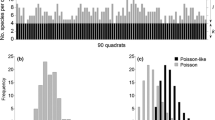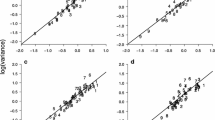Abstract
The cover, biomass, density, and frequencies of occurrence of individual species are important measures for characterizing plant communities. Examination of the statistical properties of vegetation data obtained through a quadrat survey provides insight into the spatial structure of plant communities and plant species diversity. In community analysis, we assume that x is theoretical variance calculated under the assumption that the abundance of a species follows a random distribution among quadrats (which we can obtain easily), and y is quadrat-to-quadrat variance calculated based on the observed data for a species. If the relationship y = Axb or logy = logA + blogx holds for two measurable traits of the plant community, x and y, the relationship is referred to as the power law, where A and b are constants. Then, an ideal index for measuring the spatial heterogeneity (δ) of the vegetation variable for each species was defined as δ = logy – logx. If δ = 0, the spatial heterogeneity of the species is random; if δ > 0, the heterogeneity exceeds a random pattern; and if δ < 0, the heterogeneity is less than a random pattern. In previous works in 2001 and 2014, we demonstrated that using the power law based on occurrence and density is a valuable approach to vegetation surveys and analyses. In this paper, the power law is mathematically extended and practical evidence is given for its application to cover and biomass of each species within a plant community. All measurements of cover, biomass, density, and frequency of occurrences were fitted to the power law, and plots of δ against the abundance values of these variables for each species in the community well described abundance and spatial pattern of each species in the environment. The power law is applicable not only to small-scale quadrats such as 50 × 50 cm but also to large-scale vegetation maps obtained using remote sensing and aerial photographic techniques.







Similar content being viewed by others
References
Bartome JW, Kosco BH (1982) Estimating browse production by deershrub (Ceonothus integerrimus). J Range Manag 35:671–672
Begon M, Harper JL, Townsend CR (1996) Ecology, individuals, populations and communities, 3rd edn. Blackwell, London
Bliss CI, Fisher RA (1953) Fitting the negative binomial distribution to biological data and notes on the effective fitting of the negative binomial. Biometrics 9:176–200. https://doi.org/10.2307/3001850
Bonham CD (2013) Measurements for terrestrial vegetation, 2nd edn. Wiley, New York
Braun-Blanquet J (1928) Pflanzensoziologie. Grundzüge der Vegetationskunde. Springer, Berlin
Braun-Blanquet J (1932/1951) Plant sociology: the study of plant communities. McGraw-Hill, New York (English translation of the above publication)
Chen J, Shiyomi M (2008) Analysis of the spatial heterogeneity of vegetation survey data with replications using power law. Jpn Grassl Sci 53:282–288 (In Japanese with English abstract)
Chen J, Shiyomi M (2014) Spatial pattern model of herbaceous plant mass at species level. Ecol Inf 24:124–131. https://doi.org/10.1016/j.ecoinf.2014.08.001
Chen J, Shiyomi M, Yamamura Y, Hori Y (2006) Distribution model and spatial variation of cover in grassland vegetation. Grassl Sci 52:167–173. https://doi.org/10.1111/j.1744-697X.2006.00065.x
Chen J, Shiyomi M, Bonham CD, Yasuda T, Hori Y, Yamamura Y (2008a) Plant cover estimation based on the beta distribution in grassland vegetation. Ecol Res 23:813–819. https://doi.org/10.1007/s11284-007-0443-3
Chen J, Yamamura Y, Hori Y, Shiyomi M, Yasuda T, Zhou H, Li Y, Tang Y (2008b) Small-scale species richness and its spatial variation in an alpine meadow on the Qinghai-Tibet Plateau. Ecol Res 23:657–663. https://doi.org/10.1007/s11284-007-0423-7
Chen J, Huang D, Shiyomi M, Hori Y, Yamamura Y (2008c) Spatial heterogeneity and diversity of vegetation at the landscape level in Inner Mongolia, China, with special reference to water resources. Landsc Urban Plann 82:222–232. https://doi.org/10.1016/j.jaridenv.2007.11.013
Chen J, Shiyomi M, Hori Y, Yamamura Y (2008d) Frequency distribution models for spatial patterns of vegetation abundance. Ecol Model 211:403–410. https://doi.org/10.1016/j.ecolmodel.2007.09.017
Chen J, Hori Y, Yamamura Y, Shiyomi M (2008e) Relationships between species richness, composition, and spatial heterogeneity measured using binary occurrence counts cover, and biomass in grassland vegetation. Jpn Grassl Sci 54:115–122 (In Japanese with English abstract)
Chen J, Okumura K, Takada H (2010) Estimation of clover biomass and percentage in a performance trial of white clover-timothy binary mixtures: use of multiple regression equations incorporating plant cover measured with the grid-point plate. Grassl Sci 56:127–133. https://doi.org/10.1111/j.1744-697X.2010.00184.x
Chen J, Shiyomi M, Wuyunna, Hori Y, Yamamura Y (2015) Vegetation and its spatial pattern analysis on salinized grasslands in the semiarid Inner Mongolia steppe. Grassl Sci 61:121–130. https://doi.org/10.1111/grs.12084
Chen J, Gáborčík N, Shiyomi M (2016) A probability distribution model of small-scale species richness in plant communities. Ecol Inf 33:101–108. https://doi.org/10.1016/j.ecoinf.2016.04.003
Chen J, Shiyomi M, Bai H (2018) A timesaving estimation of per-quadrat species number in grassland communities based on a Poisson-like model. Ecol Res 33:427–434. https://doi.org/10.1007/s11284-017-1544-2
David F, Moore PG (1954) Notes on contagious distributions in plant populations. Ann Bot 18:47–53. https://doi.org/10.1093/oxfordjournals.aob.a083381
Fridley JD, Peet RK, Wentworth TR, White S (2005) Connecting fine- and broad-scale species-area relationships of southeastern U.S. flora. Ecology 86:1172–1177. https://doi.org/10.1890/03-3187
Guan Q, Chen J, Wei Z, Wang Y, Shiyomi M, Yang Y (2016) Analyzing the spatial heterogeneity of number of plant individuals in grassland community by using power law model. Ecol Model 320:316–321. https://doi.org/10.1016/j.ecolmodel.2015.10.019
Hori Y, Shiyomi M, Aikawa S, Ogitsu H, Tomimatsu H, Yasuda T (2005) Spatial pattern differences in land use between mountainous, agriculture and city districts in Ibaraki Prefecture, Japan. Jpn J Ecol 55:11–19 (In Japanese with English abstract)
Huang D, Shiyomi M, Chen J, Takahashi S, Hori Y, Yamamura Y, Wang Y (2004) Spatial heterogeneity of vegetation in Inner Mongolia, China. Grassl Sci 50:319–328. https://doi.org/10.14941/grass.50.319
Huang D, Liu X, Song B, Chen J, Shiyomi M, Wang Y, Takahashi S, Hori Y, Yamamura Y (2007) Vegetation spatial heterogeneity of different soil regions in Inner Mongolia, China. Tsinghua Sci Technol 12:413–423. https://doi.org/10.1016/S1007-0214(07)70063-9
Islam T, Fukuda E, Shiyomi M, Shaibur MR, Kawai S, Tsuiki M (2010) Effects of feces on spatial distribution patterns of grazed grassland communities. Agric Sci China 9:121–129. https://doi.org/10.1016/S1671-2927(09)60075-4
Kent M (2012) Vegetation description and data analysis, a practical approach, 2nd edn. Wiley, Oxford
Kuno E (1968) Studies on the population dynamics of rice leafhoppers in a paddy field. Bull Natl Kyushu Agric Experi Stat 14:131–246 (In Japanese with English abstract)
Lennon JJ, Kunin WE, Hartley S (2002) Fractal species distributions do not produce power-law species-area relationships. Oikos 97:378–386. https://doi.org/10.1034/j.1600-0706.2002.970308.x
Madden LP, Hughes G (1995) Plant disease incidence: distribution, heterogeneity, and temporal analysis. Annu Rev Phytopathol 33:529–564. https://doi.org/10.1146/annurev.py.33.090195.002525
Maestre FT, Escudero A (2009) Is the patch size distribution of vegetation a suitable indicator of desertification processes? Ecology 90:1729–1735. https://doi.org/10.1890/08-2096.1
McMahon T (1973) Size and shape in biology. Science 179:1201–1204. https://doi.org/10.1126/science.179.4079.1201
Morisita M (1959) Measuring of the dispersion of individuals and analysis of the distributional pattern. Mem Fac Sci Kyushu Univ Ser E (Biol) 2:215–235
Morisita M (1962) Iδ-index, a measure of dispersion of individuals. Res Popul Ecol 4:1–7
Pielou EC (1977) Mathematical ecology. Wiley, New York
Shiyomi M, Nakamura K (1964) Experimental studies on the distribution of the aphid counts. Res Popul Ecol 6:79–87
Shiyomi M, Takai A (1979) The spatial pattern infected or infested and negative hyper-geometric series. Jpn J Appl Ent Zool 23:224–229. https://doi.org/10.1303/jjaez.23.224In Japanese with English abstract)
Shiyomi M, Okada M, Takahashi S, Tang Y (1998) Spatial pattern changes in aboveground plant biomass in a grazing pasture. Ecol Res 13:313–322
Shiyomi M, Takahashi S, Yoshimura J (2000) A measure for spatial heterogeneity of a grassland vegetation based on the beta-binomial distribution. J Veg Sci 11:627–632. https://doi.org/10.2307/3236569
Shiyomi M, Takahashi S, Yoshimura J, Yasuda T, Tsutsumi M, Tsuiki M, Hori Y (2001) Spatial heterogeneity in a grassland community: use of power law. Ecol Res 16:487–495. https://doi.org/10.1046/j.1440-1703.2001.00411.x
Southwood TRE, Henderson PA (2000) Ecological methods. Blackwell Science, London
Taylor LR (1961) Aggregation, variance and the mean. Nature 189:732–735
Wild O (2010) Data analysis in vegetation ecology. Wiley, Chichester
Wuyunna, Zhang F, Shiyomi M, Hu G (2011) Analysis of species heterogeneity in the Hulunbeier steppe with different grazing intensities by a power law model. J Desert Res 31:689–697 (In Chinese with English abstract)
Xie XM, Tang W, Zhong PT, Shiyomi M (2008) Analysis of spatial heterogeneity of the weed community in a manilagrass lawn using power-law. In: Stier JC et al (eds) Proceedings of 2nd IC Turfgrass Acta Horticultureae 783:529–534
Xie XM, Jian YZ, Wen XN (2009) Spatial and temporal dynamics of the weed community in a seashore Paspalum turf. Weed Sci 57:248–255. https://doi.org/10.1614/WS-08-124.1
Zwillinger D, Kokosa S (1999) Standard probability and statistics tables and formulae. Chapman & Hall/CRC, Boca Raton
Author information
Authors and Affiliations
Corresponding author
Additional information
Publisher's Note
Springer Nature remains neutral with regard to jurisdictional claims in published maps and institutional affiliations.
Electronic supplementary material
Below is the link to the electronic supplementary material.
Rights and permissions
About this article
Cite this article
Chen, J., Shiyomi, M. A power law model for analyzing spatial patterns of vegetation abundance in terms of cover, biomass, density, and occurrence: derivation of a common rule. J Plant Res 132, 481–497 (2019). https://doi.org/10.1007/s10265-019-01116-8
Received:
Accepted:
Published:
Issue Date:
DOI: https://doi.org/10.1007/s10265-019-01116-8




